“I live in Belize, way out in the jungle,” is not a sentence I thought I’d ever say, but now, it rolls right off my tongue. Ten years ago, when my husband Jim and I vacationed here with family, I knew almost nothing about this small, still-developing Caribbean and Central American nation, population of about 440,000. Just two years after that vacation, we purchased a 475-square-foot cement home in the Mosquitoville neighborhood of San Ignacio, one of the larger towns in the country, with a population of approximately 27,000, including its “twin” town, Santa Elena.
A year later, we drove from Texas to Belize with a dog, some power tools, and a five-by-five-foot working Maya calendar Jim made, stored inside a box on the roof. Now, we live a 25-minute drive from that first house near the village of San Antonio, or Oxmul Kah, “the place of the three hills” in Yucatec Maya. Our home is called Hun Chuen, named for one of the monkey gods in the Popol Vuh, a sacred text of the Kʼich’eʼ Maya people. We’re right up against protected forest, acre upon acre of flora, fauna and ancient Maya structures buried under our feet.
Getting used to jungle life and navigating multiple, very different cultures takes time, but after experiencing many daily challenges and surprises, many of which left us shaking our heads in bemusement, it’s all becoming my new normal. While I wasn’t prepared for a vastly different life, deciphering all the cultural cues, wondering where to get the ingredients I needed to make a familiar dish to alleviate my homesickness, I was up for anything.
On most days, I sit typing away on my laptop at a table under our palapa, a vast, open-sided building made from tree trunks and thatched with 800 cohune leaves culled from our land. It’s where our kitchen is as well as a dining area that becomes a screening room at night. At any moment, I might hear troops of howler monkeys in the distance, or the roar of one just 20 feet away, taunting our eight rescue dogs. I listen to the croak of a toucan high in a tree and the zoom of a hummingbird speeding to a feeder. I’m surrounded by jungle life — lush, green plants and fruit trees, all manner of orchids, skittering geckos, and iguanas. The occasional agouti will hop around in one of the yards. It’s a good thing I’m okay with spiders.

When we first moved here, I’d occasionally wail, “Why does everything have to be so hard!” The water pipe burst, a brush fire once rushed toward our yard, and no firemen came to help. The ceiling was so full of bat guano, it almost collapsed. Now, after seven years here, I no longer get so frustrated, even when the entire country loses power.
I’ve learned to do without my favorite foods from home, my precious Hellman’s mayo, NY-style pizza, and a selection of 100 cheeses in the deli. I can wait until my favorite seasonal fruits and vegetables are back in the market again. I’m fine with an eight-month lobster season and no oysters. Learning to eat with the seasons, talking to our local farmers about what they’re harvesting next, and cooking simple, delicious dishes at home is my jam now.

Just a few years ago, I was dining out almost every night, hobnobbing with “celebrity chefs” and indulging in 15-course tasting menus in my role as a food journalist. Now, most nights I have dinner with The Three Sisters, the bean, maize and squash trio that are staples in Central American agriculture and cuisine, grown in the milpas in Oxmul Kah. While the village is known throughout the country as the largest source of peanuts, farmers also grow those three companion crops, each one with a role in helping the others thrive.
Much like those Three Sisters, everyone in the village has a role in helping the community succeed, grow and thrive. I’ve learned that selling freshly made tamales helps families get through the lean, low-tourist season months and that a bag of mangos can be a “thank you.” When someone’s ill, there’s a fundraising barbeque and the whole village shows up in support.
As foreigners, we’re differentiated from the locals on a few levels. Most foreigners here are American and Canadian and primarily White in a country where at least 95% of the population are BIPOC. There’s an economic difference, too. The average minimum wage for a Belizean is $2.50 US an hour and many immigrants from the US or Canada are affluent by comparison. American and Canadian immigrants here tend to live in larger homes and away from town and village centers. They tend to keep within their own groups rather than mingle with locals, too.
So, how do you become part of a community when you’re perceived as “other?” It helps that my husband is a Maya history and culture nerd and can speak some Maya, but for me, it’s food that’s helping me to navigate the cultural differences and become more integrated. Every day, something crazy and wonderful happens in this new Belizean life of mine, and each day I learn more about what it means to be part of the community through the language of food. ![]()
